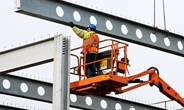Steel Markets

AGC: Construction Costs Soar in May
Written by Sandy Williams
June 14, 2018
Association Officials Say the Threat of New Tariffs Has Already Led to Dramatic Increases in the Cost of Many Construction Materials, Warn Prices Will Grow as the New Trade Restrictions Take Effect
Reprinted with permission of the Associated General Contractors of America, Wednesday, June 13, 2018:
Construction costs accelerated again in May, with steep increases for a wide range of building and road materials, including many that are subject to tariffs that could drive prices still higher, according to an analysis by the Associated General Contractors of America of new Labor Department data. Association officials say that the construction industry will bear a heavy share of the tariffs’ costs.
“Prices jumped at double-digit annual rates for metals, lumber and plywood, and diesel fuel, while ready-mixed concrete, asphalt paving and roofing materials also had unusually large increases,” said the association’s chief economist, Ken Simonson. “The cost of all goods used in construction rose 8.8 percent from May 2017 to May 2018, the steepest annual increase in nearly seven years.”
From May 2017 to May 2018, the producer price index jumped by 17.3 percent for aluminum mill shapes, 13.9 percent for lumber and plywood, 13.8 percent for copper and brass mill shapes and 10.5 percent for steel mill products. Other construction inputs that rose sharply in price from May 2017 to May 2018 include diesel fuel, 44.5 percent; asphalt felts and coatings, 8.9 percent; ready-mixed concrete, 6.5 percent; and paving mixtures and blocks, 5.2 percent.
The U.S. imposed steel and aluminum tariffs on imports from Canada, Mexico and the European Union on May 31. The impact from these tariffs is not reflected yet in the most recent data.
“These increases far outstripped the 4.2 percent rise in the price index for new construction, implying that contractors are facing a severe squeeze on costs for both ongoing and new projects,” Simonson added. “Moreover, tariffs imposed on steel and aluminum since this data was collected in mid-May are likely to drive contractors’ costs still higher.”
The producer price index for inputs to construction industries—a measure of all materials used in construction projects including items consumed by contractors, such as concrete products—rose 2.2 percent in May alone and 8.8 percent over 12 months. The year-over-year increase was the steepest since July 2011, the economist noted.
Even before they have taken effect, construction officials said the tariffs have triggered a surge of orders that mills say exceeds their current capacity, a situation that threatens to produce construction delays, budget problems and possibly cancellations for future construction projects.
“Considering the impact the mere threat of tariffs have had on materials prices and demand, prices are likely to increase further as the new trade restrictions come online,” said Stephen E. Sandherr, the association’s chief executive officer. “Forcing contractors to pay more for materials and wait longer to receive them will make construction more costly and slower.”
View producer price indexes for construction.

Sandy Williams
Read more from Sandy WilliamsLatest in Steel Markets

CRU: Sheet import demand softens as domestic price gains have slowed
US domestic sheet price gains have begun to slow as previously pulled-forward demand has led to a decline in orders.

CMC looks beyond Arizona micro-mill woes to long-term viability of construction mart
Despite the economic and geopolitical upheaval of the last five years, CMC President and CEO Peter Matt points out that the construction market has been an essential element of the way forward.

US importers face stricter rules under revamped S232 tariffs
“CBP expects full compliance from the trade community for accurate reporting and payment of the additional duties. CBP will take enforcement action on non-compliance," the agency said in a March 7 bulletin.

Steel exports rebound in January
US steel exports recovered to a five-month high in January after having fallen to a two-year low in December. This growth follows four consecutive months of declining exports.

Construction spending drops marginally in January
Construction spending edged down slightly in January, slipping for the first time in four months. The US Census Bureau estimated spending at a seasonally adjusted annual rate of $2,196 billion in January, down 0.2% from December’s downward revised rate. The January figure is 3.3% higher than a year ago. January’s result, despite the slight erosion, […]
